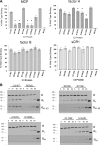Mutations in complement C3 predispose to development of atypical hemolytic uremic syndrome
- PMID: 18796626
- PMCID: PMC2597601
- DOI: 10.1182/blood-2008-01-133702
Mutations in complement C3 predispose to development of atypical hemolytic uremic syndrome
Abstract
Atypical hemolytic uremic syndrome (aHUS) is a disease of complement dysregulation. In approximately 50% of patients, mutations have been described in the genes encoding the complement regulators factor H, MCP, and factor I or the activator factor B. We report here mutations in the central component of the complement cascade, C3, in association with aHUS. We describe 9 novel C3 mutations in 14 aHUS patients with a persistently low serum C3 level. We have demonstrated that 5 of these mutations are gain-of-function and 2 are inactivating. This establishes C3 as a susceptibility factor for aHUS.
Figures


Similar articles
-
A large family with a gain-of-function mutation of complement C3 predisposing to atypical hemolytic uremic syndrome, microhematuria, hypertension and chronic renal failure.Clin J Am Soc Nephrol. 2009 Aug;4(8):1356-62. doi: 10.2215/CJN.06281208. Epub 2009 Jul 9. Clin J Am Soc Nephrol. 2009. PMID: 19590060 Free PMC article.
-
Novel C3 mutation p.Lys65Gln in aHUS affects complement factor H binding.Pediatr Nephrol. 2012 Sep;27(9):1519-24. doi: 10.1007/s00467-012-2183-z. Epub 2012 Jun 6. Pediatr Nephrol. 2012. PMID: 22669319 Free PMC article.
-
Combined complement gene mutations in atypical hemolytic uremic syndrome influence clinical phenotype.J Am Soc Nephrol. 2013 Feb;24(3):475-86. doi: 10.1681/ASN.2012090884. Epub 2013 Feb 21. J Am Soc Nephrol. 2013. PMID: 23431077 Free PMC article.
-
Atypical hemolytic uremic syndrome.Orphanet J Rare Dis. 2011 Sep 8;6:60. doi: 10.1186/1750-1172-6-60. Orphanet J Rare Dis. 2011. PMID: 21902819 Free PMC article. Review.
-
Complement activation in diseases presenting with thrombotic microangiopathy.Eur J Intern Med. 2013 Sep;24(6):496-502. doi: 10.1016/j.ejim.2013.05.009. Epub 2013 Jun 4. Eur J Intern Med. 2013. PMID: 23743117 Review.
Cited by
-
Genetic variability shapes the alternative pathway complement activity and predisposition to complement-related diseases.Immunol Rev. 2023 Jan;313(1):71-90. doi: 10.1111/imr.13131. Epub 2022 Sep 11. Immunol Rev. 2023. PMID: 36089777 Free PMC article. Review.
-
Complement therapy in atypical haemolytic uraemic syndrome (aHUS).Mol Immunol. 2013 Dec 15;56(3):199-212. doi: 10.1016/j.molimm.2013.05.224. Epub 2013 Jun 28. Mol Immunol. 2013. PMID: 23810412 Free PMC article. Review.
-
Deletion of Crry and DAF on murine platelets stimulates thrombopoiesis and increases factor H-dependent resistance of peripheral platelets to complement attack.J Immunol. 2013 Mar 15;190(6):2886-95. doi: 10.4049/jimmunol.1202536. Epub 2013 Feb 6. J Immunol. 2013. PMID: 23390291 Free PMC article.
-
Overview of C3 Glomerulopathy.Front Pediatr. 2016 May 6;4:45. doi: 10.3389/fped.2016.00045. eCollection 2016. Front Pediatr. 2016. PMID: 27200326 Free PMC article. Review.
-
Genetics and complement in atypical HUS.Pediatr Nephrol. 2010 Dec;25(12):2431-42. doi: 10.1007/s00467-010-1555-5. Epub 2010 Jun 6. Pediatr Nephrol. 2010. PMID: 20526633 Free PMC article. Review.
References
-
- Warwicker P, Goodship THJ, Donne RL, et al. Genetic studies into inherited and sporadic haemolytic uraemic syndrome. Kidney Int. 1998;53:836–844. - PubMed
-
- Caprioli J, Bettinaglio P, Zipfel PF, et al. The molecular basis of familial hemolytic uremic syndrome: mutation analysis of factor H gene reveals a hot spot in short consensus repeat 20. J Am Soc Nephrol. 2001;12:297–307. - PubMed
-
- Dragon-Durey MA, Fremeaux-Bacchi V, Loirat C, et al. Heterozygous and homozygous factor H deficiencies associated with hemolytic uremic syndrome or membranoproliferative glomerulonephritis: report and genetic analysis of 16 cases. J Am Soc Nephrol. 2004;15:787–795. - PubMed
Publication types
MeSH terms
Substances
Grants and funding
LinkOut - more resources
Full Text Sources
Other Literature Sources
Molecular Biology Databases
Miscellaneous

